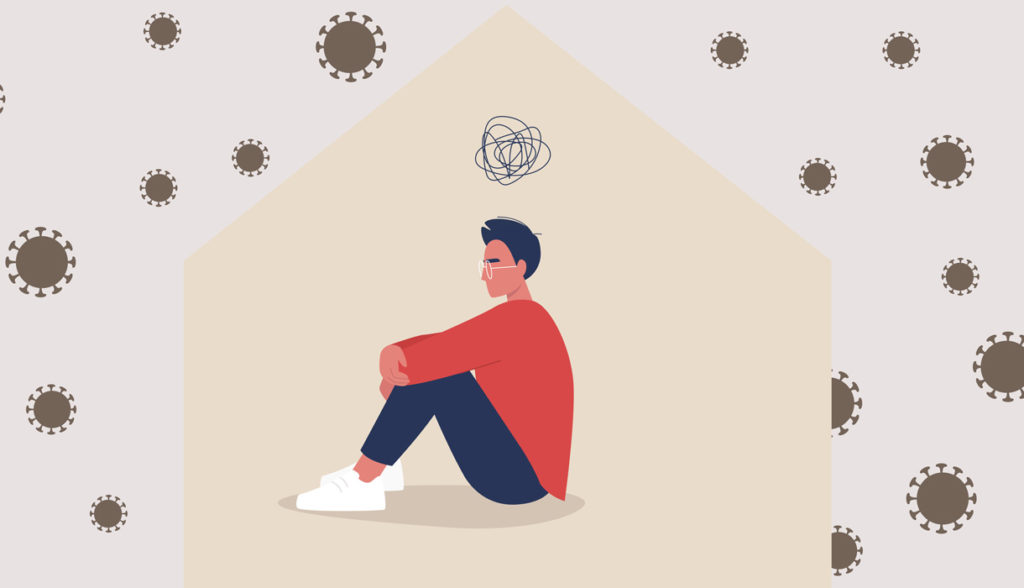
Managing Loneliness in a COVID World
Find ways to connect safely with others—and yourself.

After scrolling through the many photos of mask-free partying on Instagram’s now-infamous @GaysOverCovid account, one can’t help but wonder how people could be so cavalier in the midst of a pandemic. The anonymously-curated social-media account is dedicated to publicly exposing and shaming LGBTQ people (mostly cisgender gay men) who get together for parties (of either the dinner or circuit variety) and then post pictures of the event to their social-media accounts.
Clearly, there’s something deeper here that can and should be considered—beyond the obvious controversy surrounding the practice of public shaming. Rather than immediately posting judgmental comments about foolish and risky behavior, it can be helpful to have a bit of compassion for those maskless party boys who are no doubt struggling with intense COVID fatigue. In truth, there is a great deal of loneliness at the root of this potentially life-threatening desire to connect at all costs.
For many of us, loneliness has characterized much of the past year. With so many restrictions on both public and private gatherings, we are spending a great deal of time in varying states of self-quarantine. The arrival of Valentine’s Day this month throws this loneliness into stark relief that can further intensify our emotional distress. We all wish that we could return to some semblance of normalcy.
But what, exactly, is loneliness? Although we all feel lonely at some point, actually describing this emotion can be challenging. It can be helpful to think of it as an unpleasant feeling of disconnectedness or isolation. This is different from simply being alone, or having time to one’s self—which can be rejuvenating to both mind and body. Solitude is not the same as loneliness or isolation.
Not all loneliness is created equal. Psychiatry professor Sarvada Tiwari, in speaking of his work with older adults, theorizes there are actually three types of loneliness: situational, developmental, and internal. Drawing this distinction is helpful, since the potential causes and ways of managing these conditions can be quite different.
Situational Loneliness
Situational loneliness develops in response to socio-economic, environmental, or cultural factors. Importantly, these external forces are oftentimes out of our control. These past several months are a great example. A global pandemic and the economic shutdown brought on by stay-at-home orders set the stage for widespread isolation. If you find yourself frequently saying, “I miss being around and seeing people,” then situational loneliness may be what you’re experiencing.
Developmental Loneliness
Developmental loneliness can occur as a result of the conditions of our upbringing, and the ways in which we are socialized into family and community. For example, a traumatic childhood or young adulthood can result in patterns of thinking and behavior that reflect the very real lack of safety and comfort that occurred earlier in life.
While feeling the need to spend time with others is healthy and natural, feeling insecure in one’s primary relationships with parents or family can lessen that desire to closely engage. Also, when there is a sense of instability due to financial or emotional strain in the home, people will often question the security of the relationships they have. Rather than risk insecurity, the phrase “I would rather be alone” may become a common refrain.
Internal Loneliness
Internal loneliness is when someone perceives themselves as being alone, despite evidence to the contrary. Chronic feelings of low self-worth, or difficulty with maintaining positive self-esteem, can drive the feeling that we are not truly connected with others. Those people may have a pervasive feeling that “I am alone in the world.” As a result, other negative emotions of sadness, hopelessness, or despair can creep in and take hold.
Alone, but Not Lonely
Striking a balance between having time to ourselves and closely engaging with others is a challenge for many of us. When our emotional barometer is out of alignment, it can be easy to either feel lonely or become overly clingy. When you are feeling lonely, ask yourself: What is the cause of my loneliness in this moment? Is it that I am missing people, or am I being triggered by something from my past that requires further examination?
If situational loneliness is the culprit, thinking through ways of safely connecting with others can be helpful. Using online technology, or gathering outdoors while maintaining an appropriate distance, can provide opportunities for socially recharging. If developmental or internal loneliness is more prominent, then monitoring for chronic feelings of emptiness, separateness, or despair is critical—and may signal the need for additional mental-health evaluation and treatment.
Valuing Your Time Apart from Others
At the same time that you strive for social connection, it’s important to have time to yourself. Finding a designated space away from others can help you develop a deeper connection with your internal thought life, and represents the core of your individualism.
Becoming your own best friend may be exactly what’s needed to combat feelings of isolation. The trick is to approach this task with a spirit of curiosity and adventure, rather than with feelings of dread. The next time you’re alone with nothing but your own thoughts, ask yourself: What can I do to get to know myself better?
This article appears in the February 2021 edition of OutSmart magazine.











Comments